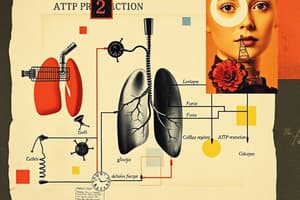Podcast
Questions and Answers
How many ATP are produced from one glucose in the TCA cycle?
How many ATP are produced from one glucose in the TCA cycle?
- 8
- 6
- 4
- 2 (correct)
What is the total amount of NADH produced from one glucose during glycolysis and the TCA cycle combined?
What is the total amount of NADH produced from one glucose during glycolysis and the TCA cycle combined?
- 12
- 6
- 8
- 10 (correct)
What is produced as a waste product during the breakdown of pyruvate in the TCA cycle?
What is produced as a waste product during the breakdown of pyruvate in the TCA cycle?
- FADH2
- ATP
- CO2 (correct)
- NADH
What does the energy stored in NADH and FADH2 contribute to in aerobic respiration?
What does the energy stored in NADH and FADH2 contribute to in aerobic respiration?
How many CO2 molecules are produced from one glucose during the TCA cycle?
How many CO2 molecules are produced from one glucose during the TCA cycle?
What is the purpose of the ATP produced during glycolysis and the TCA cycle?
What is the purpose of the ATP produced during glycolysis and the TCA cycle?
What is the significance of producing more than one pyruvate from glucose during glycolysis?
What is the significance of producing more than one pyruvate from glucose during glycolysis?
What is the primary role of FADH2 in cellular respiration?
What is the primary role of FADH2 in cellular respiration?
After glycolysis, what happens to the 2 pyruvate molecules produced?
After glycolysis, what happens to the 2 pyruvate molecules produced?
What happens to the 6 CO2 produced during the TCA cycle?
What happens to the 6 CO2 produced during the TCA cycle?
What is the net yield of ATP from glycolysis per molecule of glucose?
What is the net yield of ATP from glycolysis per molecule of glucose?
Where does the tricarboxylic acid (TCA) cycle occur in eukaryotic cells?
Where does the tricarboxylic acid (TCA) cycle occur in eukaryotic cells?
After glycolysis, what is the next product formed from pyruvate before entering the TCA cycle?
After glycolysis, what is the next product formed from pyruvate before entering the TCA cycle?
Which molecule is not produced during the TCA cycle for each pyruvate?
Which molecule is not produced during the TCA cycle for each pyruvate?
What is the overall equation for aerobic respiration?
What is the overall equation for aerobic respiration?
Which of the following processes is NOT part of aerobic respiration?
Which of the following processes is NOT part of aerobic respiration?
What is produced in glycolysis that carries high-energy electrons?
What is produced in glycolysis that carries high-energy electrons?
During which process is glucose initially broken down?
During which process is glucose initially broken down?
How many ATP are generated for each pyruvate molecule in the TCA cycle?
How many ATP are generated for each pyruvate molecule in the TCA cycle?
What main purpose does aerobic respiration serve for cells?
What main purpose does aerobic respiration serve for cells?
Aerobic respiration can produce approximately 38 ATP from one glucose molecule.
Aerobic respiration can produce approximately 38 ATP from one glucose molecule.
The TCA cycle is located only in the cytoplasm of eukaryotic cells.
The TCA cycle is located only in the cytoplasm of eukaryotic cells.
During glycolysis, one glucose molecule is converted into two pyruvate molecules.
During glycolysis, one glucose molecule is converted into two pyruvate molecules.
Only eukaryotic organisms perform aerobic respiration.
Only eukaryotic organisms perform aerobic respiration.
Glycolysis yields a net gain of 2 ATP per glucose molecule.
Glycolysis yields a net gain of 2 ATP per glucose molecule.
Acetyl coA is formed from pyruvate before entering the glycolysis pathway.
Acetyl coA is formed from pyruvate before entering the glycolysis pathway.
NADH and FADH2 are produced in both glycolysis and the TCA cycle.
NADH and FADH2 are produced in both glycolysis and the TCA cycle.
The overall equation for aerobic respiration includes the production of sulfur dioxide.
The overall equation for aerobic respiration includes the production of sulfur dioxide.
The early steps of glycolysis require 4 ATP to start the process.
The early steps of glycolysis require 4 ATP to start the process.
The TCA cycle is also known as the Krebs cycle and citric acid cycle.
The TCA cycle is also known as the Krebs cycle and citric acid cycle.
One glucose molecule results in the production of 6 pyruvates during glycolysis.
One glucose molecule results in the production of 6 pyruvates during glycolysis.
During the TCA cycle, a single glucose yields a total of 10 NADH.
During the TCA cycle, a single glucose yields a total of 10 NADH.
The TCA cycle produces 6 CO2 molecules for each glucose molecule.
The TCA cycle produces 6 CO2 molecules for each glucose molecule.
The total ATP yield directly from the TCA cycle per glucose is 4 ATP.
The total ATP yield directly from the TCA cycle per glucose is 4 ATP.
NADH and FADH2 are byproducts of glycolysis and TCA cycle, releasing energy directly.
NADH and FADH2 are byproducts of glycolysis and TCA cycle, releasing energy directly.
The main waste product of glucose metabolism in the TCA cycle is water.
The main waste product of glucose metabolism in the TCA cycle is water.
The 2 FADH2 produced from the TCA cycle are responsible for transporting electrons to the electron transport chain.
The 2 FADH2 produced from the TCA cycle are responsible for transporting electrons to the electron transport chain.
Glycolysis occurs in the mitochondria of the cell.
Glycolysis occurs in the mitochondria of the cell.
Each glucose molecule processed yields a net gain of 2 ATP from glycolysis.
Each glucose molecule processed yields a net gain of 2 ATP from glycolysis.
The energy stored in NADH is released during oxidative phosphorylation.
The energy stored in NADH is released during oxidative phosphorylation.
Study Notes
Aerobic Respiration
- Most common catabolic strategy used by eukaryotes and prokaryotes.
- Also called "cellular respiration" but not all prokaryotes use it.
- Equation: Glucose + 6 Oxygen → 6 Carbon Dioxide + 6 Water
- Yields approximately 38 ATP per glucose molecule
Glycolysis
- Location: Cytoplasm of eukaryotes and prokaryotes.
- Glucose is broken down into 2 pyruvate molecules.
- Early steps require 2 ATP, later steps yield 4 ATP (net yield: 2 ATP).
- 2 NAD+ are converted into 2 NADH.
Tricarboxylic Acid Cycle (TCA)
- Also known as Kreb's cycle and citric acid cycle.
- Location: Cytoplasm of prokaryotes and mitochondrial matrix of eukaryotes.
- Pyruvate is converted into acetyl-CoA and enters the TCA cycle.
- Broken down into carbon dioxide.
- Yields 1 ATP, 4 NADH, and 1 FADH2 per pyruvate.
- Per glucose, yields: 2 ATP, 8 NADH, 2 FADH2, and 6 CO2.
Summary of Glucose Breakdown
- From 1 glucose, 2 pyruvates are produced in glycolysis, with a net gain of 2 ATP and 2 NADH.
- These 2 pyruvates are further broken down in the TCA cycle, generating 6 CO2, 2 ATP, 8 NADH, and 2 FADH2.
- This totals 4 ATP, 10 NADH, and 2 FADH2 per glucose.
- 6 CO2 are released as waste products.
- NADH and FADH2 carry energy to the next stage of aerobic respiration, the electron transport system.
Aerobic Respiration
- Most common catabolic strategy for eukaryotes and most prokaryotes
- Overall equation: C6H12O6 + 6O2 → 6CO2 + 6H2O
- Consists of three steps: Glycolysis, TCA cycle, and Electron transport system
- Generates ~38 ATP per glucose molecule
Glycolysis
- Occurs in the cytoplasm of prokaryotes and eukaryotes
- Converts one glucose molecule (6 carbons) into two pyruvate molecules (3 carbons)
- Requires 2 ATP and yields 4 ATP (net yield: 2 ATP)
- Produces 2 NADH
Tricarboxylic Acid Cycle (TCA Cycle)
- Also known as Kreb's Cycle and Citric Acid Cycle
- Occurs in the cytoplasm of prokaryotes and the mitochondrial matrix of eukaryotes
- Pyruvate is converted into acetyl CoA before entering the TCA cycle
- Breaks down acetyl CoA into carbon dioxide
- Yields 1 ATP, 4 NADH, and 1 FADH2 per pyruvate
- Per glucose: 2 ATP, 8 NADH, 2 FADH2, and 6 CO2
Summary of Yields So Far
- 4 ATP (from glycolysis and TCA cycle)
- 6 CO2 (released as waste)
- 10 NADH (2 from glycolysis, 8 from TCA)
- 2 FADH2 (from TCA)
- NADH and FADH2 carry stored energy to the electron transport system
Studying That Suits You
Use AI to generate personalized quizzes and flashcards to suit your learning preferences.
Description
Test your knowledge on cellular respiration, including glycolysis, the TCA cycle, and the overall process of aerobic respiration. Explore key concepts, equations, and ATP yield associated with glucose breakdown. Perfect for biology students looking to reinforce their understanding of energy metabolism.




